VERPLANCK--MONTROSE
CRUGERS--GEORGE'S ISLAND
The name Verplanck comes from
Johannes Van Cortlandt Verplanck, the son of Stephanus Van Cortlandt who inherited this sizable peninsula. He left it to his daughter Gertrude, who married Philip VerPlanck in 1718. The couple had nine children. Called VerPlanck Point, it remained in the family until the southern portion was sold to an investor's syndicate in 1836. The extensive community planned by the syndicate never materialized, although the hamlet of Verplanck enjoyed a measure of prosperity during the brickmaking era. Many of the brick homes built by brickyard workers in Verplanck are architecturally interesting.
(Source:Naming the Land: What's Your Local Place Name I.Q.?)
From a commemorative roadside plaque on Riverview Ave in Verplanck:
"In the 1840s John Henry, the principal landowner of Verplanck's Point at that time, opened the first brickyard north of Steamboat Dock.
In 1884, there were 10 separate brickyards operating in Verplanck, employing about 425 men, mostly Irish immigrants.
The brick making season lasted about 150 days and the combined output of the yards was apx. 60 million brick per year.
At the beginning of the 20th century the clay deposits were becoming exhausted and the brick-making era was coming to
a close. By 1914 there were only 2 yards operating in Verplanck."
In The History of the Town of Cortlandt we learn that John Henry sold some of his property to William Bleakley who opened several brickyards. Bricks sold for $3.25 per thousand. Here's an example of some of the brickyards in the Civil War period and their production for one day:
Francis Timoney -- 125,000
Adam Fisher -- 63,000
Thomas Vaughey -- 44,000
Hudson Brick Manufacturing Company -- 40,000
John Morton -- 45,000
Cyrus Travis -- 45,000
O'Brien and McConnon -- 45,000
King & Lynch -- 40,000
==========
This 1891 map of this area by F. W. Beers shows many brick companies in this general region. Right on Verplanck's Point, it lists the Bonner Brick Company to the north and the Hudson River Brick Company to the south. More brick companies were located to the south in Montrose and Crugers (Jones, F.W. Seward and Bellefuille). These yards were later operated by OBRIEN (see below) and today is the Montrose Point State Forest. Here's a Trail Map. Farther south in Crugers was the L. H. Lynch Co. yard.
(Click each map section for a larger view.)
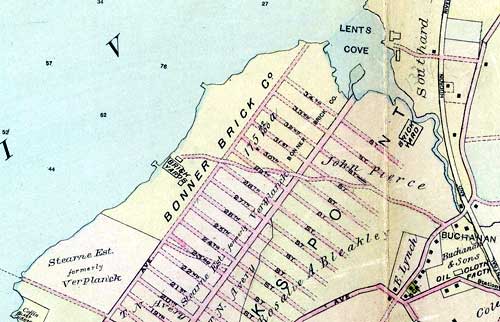
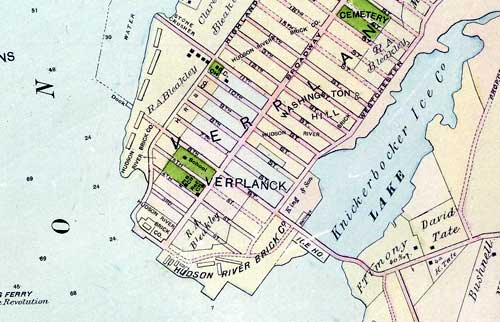
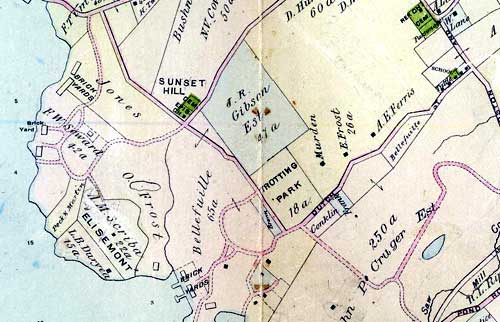
(Click each map for a larger view.)
==========
From The Golden Age of Hudson Valley Brickmaking:
Early Westchester Brickyards
One early brickyard was established at Green's Cove, between Verplanck Point and Montrose Point, by Isaac Green, a settler from Vermont. In 1833 or 1834, Green began to manufacture bricks on land leased from Joshua T. Jones. In 1837, William A. Underhill began making bricks on land owned by his father, Robert Underhill, on Croton Point.
Extensive deposits of clay and sand were discovered on Verplanck Point, and it soon became the center of the early brickmaking industry in Cortlandt. An early brickyard operator was William Bleakley, former supervisor of Cortlandt and later sheriff of Westchester County.
According to the N.Y. State Census of 1855, 37 brickyards were operating in the town of Cortlandt, employing more than a thousand workers. The only other brickyard in Westchester was located near Sing Sing in the town of Mount Pleasant and employed 16 men.
A legacy of the intensive brickmaking on Verplanck Point is the community of Verplanck itself. Still remarkably intact, it is a veritable architectural museum. Its brick public buildings, and modest brick homes and row houses in simplified Greek Revival style are seemingly frozen in time. In 1836, John Henry and nine other investors had purchased Verplanck Point with the intention of establishing a village to rival Peekskill. Their ambitious plan showed small lots along 37 numbered streets and six named avenues (Water, Hudson, Highland, Broadway, Westchester, and Union). Unfortunately, the expected population never materialized. After only eleven streets and three avenues were cut through, in 1866 Henry sold much of his land to the Hudson River Brick Manufacturing Company. Initially, this company did not undertake the manufacture of bricks but leased its land to brickmakers.
Brickmaking in 1884
Because brickmaking was an unglamorous industry requiring comparatively little capital or equipment, few records have survived. We can get a glimpse of its extent in Cortlandt in 1884 from J. Thomas Scharf's two-volume history of Westchester County.
On Verplanck Point ten brickyards employed 425 men and manufactured 400,000 bricks daily. Frank A. Timoney leased three yards, employing 150 men, Patrick King also operated three yards employing 125 men, Adam Fisher's yard employing 50 men, Thomas Vaughey's yard employing 25 men, and John Morton's two yards employing 75 men were all leased. One of Morton's yards manufactured what was described as "Croton front brick," priced at $10-12 a thousand, and the other "common brick," priced at $6 a thousand.
At Green's Cove, between Verplanck Point and Montrose Point, were the brickyards of Cyrus Travis, then the supervisor of the town of Cortlandt, and O'Brien & McConnon. Each employed 50 men.
On Montrose Point was the brickyard of James D. Avery, with 30 men. Farther south were two brickyards operated by Orrin Frost, with 100 men. On George's Island were three leased brickyards, employing 130 men. Two were operated by Tompkins & Bellefeuille and the third by Edward Bellefeuille.
At Crugers, John Peach Cruger owned two brickyards employing 70 men; one was leased to Adam Fisher.
Brick Brands
Early brickmakers occasionally scratched their initials in their bricks, but in the 1880's templates were created to make uniform marks. Eventually, rectangular wooden plates were affixed inside the molds at the bottom. These produced an indentation in each brick called a "frog" in which brickyards' names or initials appeared in raised relief. Brickmakers soon realized that the frog not only made for a lighter brick but also conserved raw material. It also helped to create a better bond between bricks laid with mortar. Builders eventually recognized brands whose quality was consistent and bought such bricks.
Most brands are easily identifiable by their names, but some initials can pose a problem: Verplanck yards: CC (Charles Carman); K&L (King and Lynch); O&McC (O'Brien & McConnon); PO (Patrick O'Brien).
Crugers yards: LHL (L.H. Lynch); L&O (Lynch & O'Brien).
Despite their size and weight, and the difficulty of exhibiting them, brick collectors today eagerly seek examples of brick brands.
(SOURCE: The Golden Age of Hudson Valley Brickmaking)
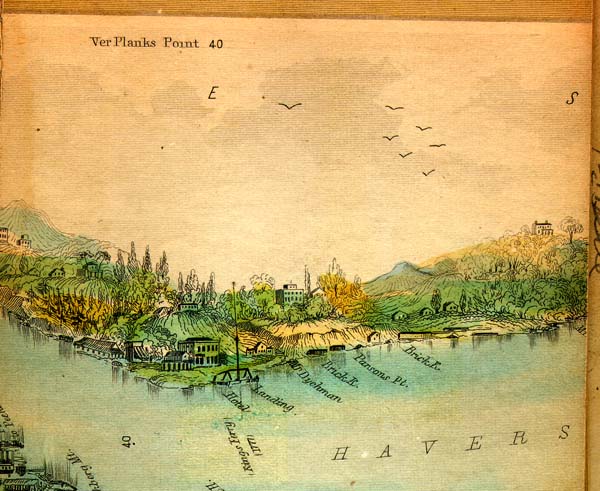
1846 engraving of Verplanck's Point from VIRTUAL TRIP UP THE HUDSON
by William Wade, Master Engraver, 1846
==========
From the 1919 edition of: Rand McNally Hudson River Guide to Places of Interest to the Tourist & Excursionist:
"Verplanck's Point, on the opposite side (from Stony Point) is the next place of historic interest after Stony Point. Between the two, in colonial times, ran the boats of the King's Ferry, on the main highway between New England and the West. The plain here was the scene, in 1778, of animated and earnest evolutions of soldiers of the American army, gaining efficiency under Baron Steuben (later Major-General), the German nobleman who offered his services to General Washington. In the Revolution it was occupied by military works to assist Stony Point in covering the ferry. It changed flags as often as Stony Point did. Additional interest is given to this point by the fact that Henry Hudson's ship, the Half Moon, dropped anchor in these waters on September 14, 1609."
==========
From: "What is a River, Anyway?"
(a post by Harry Springer on forums.lohud.com):
"In 1828 Thomas Cornell had a cement works at Rondout. In 1837 he started the Cornell
Steamboat Line out of Rondout, dominating Hudson river boat transport and several times
daily taking quarrymen, distillers, & brickmakers up to Albany & down to NYC.
It was his boats that ferried the Irish brickworkers from NYC to Steamboat Dock in
Verplanck, where they would put up at the brick boarding house still in use there today
as a multi-unit home, and do 3 month stints in one of the 34 local brickworks before
being returned to their families in NYC, much in the manner of oil platform
workers in the present day."
==========
NY Times articles on Verplanck Brickyards:
"The Trouble At Verplanck," July 21, 1888
"No Bricks From Now On," August 23, 1890
"The Brickmakers' Side," August 24, 1890
==========
Brands and Brickyard Owners and Operators in the Verplanck/Montrose area included:
(C=Crugers, G=George's Island, M=Montrose, V=Verplanck)
AVERY, James D. (The Star Brick Company of New York) (1884 - 1890) -V
Avery, T.N. (1888 - 1895) -V
Avery & Mackey (1888 - 1895 -V
Bellefeuille (sic), Henry (1870) -V
Bellefuille, Edward (1884 - 1888)) -V
E D B (Edward D. Bellefuille) (1910) -M
Bleakley, William (1847 - 1869) -V
BONNER Brick Co. (1899 - 1910) -V
CC (Charles Carman) (1888 - 1895) -C, -V
Coleman, John C. (The Star Brick Company of New York) -M
Cortlandt Brick Co. (1923) -M
Cox & Barlow (1870) -V
EH (P) WJ (E.H and W.J. Peck) (1895 - 1900) -M
E S B Co (East Shore Brick Company) (1905 - 1910) -V,
FISHER, Adam (1884 - 1895) -V
FROST, Eugene (1905) -M
Frost, Orrin (O FROST) (1888 - 1900) -M
Galligan, Patrick (1874) -C
GORMLEY Brick Company (Matthew Gormley) (1905 - 1910) -G
Green, Isaac (1833) -V
Haight, Daniel J. (1874 - 1877) -C
HB (Harry Belfal) -M
Henry, John (1842 - 1851) -V
H R B (Hudson River Brick Manufacturing Company) 1867 - 1920) -V
Hyatt, Chester (1888 - 1895) -M
JnoHLCo (John H. Lynch Company) -G
Jones, Joshua T. (1833) -V
K & L (King & Lynch) (1888 - 1905) -V
KING, Patrick (1884 - 1886) -V
LHL (L. H. Lynch) (1905 - 1910) -C
Lynch & King (1888 - 1895) -M
L & O (Lynch & O'Brien) (1911) -C
L & O BB (John Lynch & O'Brien Brothers: John and Mark) -G
Mackey, Robert. (1895) -V
MACKEY, William H. (MACKEY Yards) (1895 - 1905) -V
Manning, John H. (1895 - 1905) -C
McConnell & O'Brien (1888 - 1898) -V
Montrose Point Brick Co.(Peck and Martin) (1888 - 1900) -M
Morton, John G. (1888 - 1905) -M
NESBIT, Frank (1888 - 1890) -V
Nickerson, Charles W., (The Star Brick Company of New York) -M
OBRIEN, Patrick (1859 - 1870) -V
O'Brien, Philip (1895 - 1910) -V
O'Brien & McConnel (1884 - 1889) -V
O & MC (O'Brien & McConnon) (1890 - 1900) -V
O B & V (O'Brien & Vaughey) (1888) -V
O FROST (Orrin FROST and Co.) (1888 - 1900) -M
P O (Patrick O'Brien) -V
Peck, E.H and W.J. (1895 - 1900) -M
Peck, Nathan and Martin, Robert (The Montrose Point Brick Co. 1888 - 1900) (Peck and Martin) -M
PERLMAN, Jesse (1924) -V
R N & Co (R. Nieberg & Company) (1905) -C
Seward, F.W.
SHANERUCK Brick Co. (1905 - 1912) -V
SHAMROCK Brick Co. -V
(Star symbol) Peck, Nathan and Martin, Robert (The Montrose Point Brick Co. 1888 - 1900) (Peck and Martin) -M
Timoney, Frank A. (1867 - 1888) -V
Tompkins, William (1877) -G
Tompkins & Bellefuille (1884) -V
Travis, Cyrus (1888 - 1895) -V
Underhill Brick Co. (1904 - 1910) -V
Vaughey, John (1859) -V
Vaughey, Thomas (1884 - 1888) -V
Verplank (sic) Brick Co. (1908) -V
YOUNG, Henry (1900) -M
Whitbeck, James A. (1867 -V
Edward D. Bellefuille
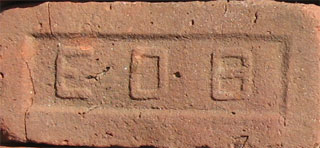
George's Island, (Montrose) NY (1910)
(this was a hard one to ID -
- thanks to Fred Rieck for this one!)
Here is an 1891 map of the Montrose/Verplanck/Crugers area by F. W. Biers showing Bellefuille's 65 acre parcel and his Brick Yards.
The site is now George's Island Park. Here's a photo. In our research, we have come upon alternate spellings of the name: Bellefeulle and Bellefeuille.
|
East Shore Brick Co.

Verplank's Point (Verplanck), NY
(1905 - 1910)
|
Eugene Frost


Montrose, NY (1905)
Croton, NY (1905 - 1910)
At Croton, Eugene Frost also used
the brand mark: EF.
|
Gormley Brick Company
Matthew Gormley
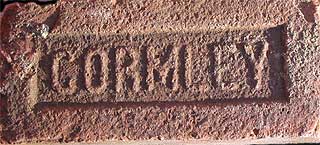
Haverstraw, NY (1895)
Verplanck/Montrose (George's Island), NY (1905 - 1910) 7 machines
From The New York Times Archives, Published: June 8, 1989:
"Matthew J. Gormley, a former brick manufacturer, died May 25 at his son's home in Garnerville, N.Y. He was 86 years old and lived in Haverstraw, N.Y.
Mr. Gormley, a graduate of Fordham Preparatory School in the Bronx, was general manager of the Gormley Brick Yards and was one of the last of the Haverstraw brick makers. His bricks were used in the construction of the state prison at Ossining, N.Y., as well as the buildings at Graymoor, the Roman Catholic institution in Garrison, N.Y.
The last shipment of Gormley bricks was sent to New York City by boat on April 13, 1938. Mr. Gormley then became a general contractor for the Army during the construction of Camp Shanks, at Orangeburg, N.Y., a major point of embarkation for troops during World War II.
He is survived by his wife, Gertrude; two sons, Matthew, of Arlington, Va., and Thomas, of Garnerville, and five grandchildren."
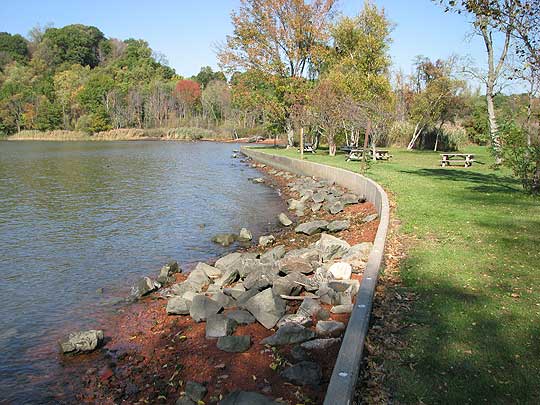
Site of the GORMLEY yard in Montrose, now George's Island Park
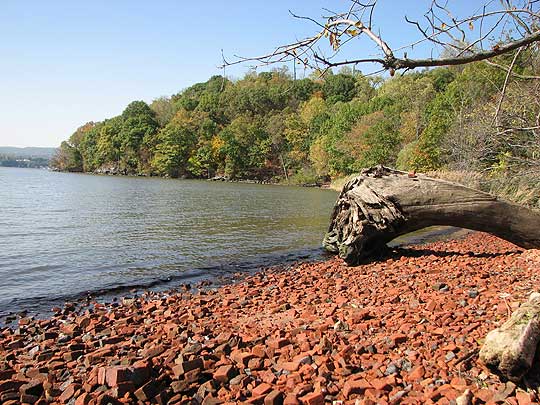
GORMLEY and Bellefuille bricks on the shore at George's Island Park
|
John Morton

Croton Landing, NY
There was also a John Morton in Montrose and Verplank as documented in New York State Museum's MARCH 1895 CLAY INDUSTRIES OF NEW YORK:
"Along the New York Central Railroad tracks a short distance south of Montrose station are the yards of C. Hyatt and J. Morton. Mr. Morton also has a covered yard on Verplank Point where front brick are made. Their banks are practically a continuation of each other. The clay is both blue and yellow and is overlain by several feet of coarse sand. Hyatt uses steam power and Morton horse power to run his machinery. The bricks are loaded on cars and shipped to various points along the Central Railroad."
Webmaster Note:
This brick was found among the ruins of Woody Crest, now Taxter Ridge Park, in Tarrytown, NY:
"Miss Helen Gould has many private charities of
which the public rarely hears. Of these the one that
interests her most no doubt is Woody Crest, her fresh-
air home and school for the children of the poor, at
Tarrytown, New York. The home is only about a
mile from her own country house, Lyndhurst, and is
one of those square, solid stone mansions with broad
piazza, wide hall and high ceilings which the Dutch
settlers were in the habit of rearing a century ago. It
stands on the crest of a wooded hill, one of the range
which divides the valley of the Hudson from that of
the Saw Mill River, and about two miles distant from
either. The view from its front porch is superb: rich
intervales green with grass and springing wheat and
shaded by groves clad in the crimson and scarlet of
autumn are at one's feet; while farther away flows the
silver tide of the Hudson with dark mountains for a
background. Miss Gould bought the house, with thirteen
acres of land surrounding it, in 1893, and at once
organized her beautiful charity."
SOURCE: Gunton's Magazine, Jan-June, 1901
Many thanks to Rob Yasinsac of hudsonvalleyruins.org for a tour of the Woody Crest ruins.
|
Patrick O'Brien
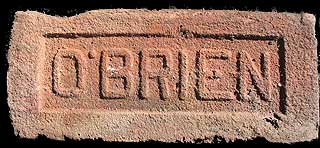
Verplanck (Montrose), NY, 3 machines
Found at the brickyard site, now Montrose Point State Forest, off Kings Ferry Road. We also found OBRIEN
in the ruins of the Peekskill Centennial Hose Firehouse (see below).
In 1858, the O'Brien Brickyards of Verplanck donated bricks to build St. Augustine Church in Ossining, NY with the provision that should any of the owner's descendants ever need money, the church would pay the full value of the bricks." Thus, the red brick was delivered and the little church was constructed up to the side doors...and as parishioners tell: "a later generation paid for the bricks."
(Source: https://eaglepark.org/History/History_P1.htm)
|
O'Brien & Vaughey
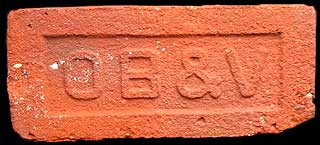
Fishkill Landing and Verplanck, NY
Found in the ruins of the Centennial Hose Firehouse, Peekskill, NY
Other bricks found in the firehouse ruins:
OBRIEN (scroll up) and (star logo) most likely made by the Peck & Martin Co.
Video of Firehouse Collapse
Historic Peekskill firehouse collapses in move
By Robert Marchant | The Journal News | August 21, 2008
PEEKSKILL, N.Y. -- A 108-year-old firehouse in Peekskill collapsed
into a heap of rubble just before noon today.
The Centennial Firehouse was set to be moved a few hundred yards away,
but a mechanical mishap caused the structure to tumble over as workers
began to rotate it. The job foreman ran from the building
seconds before it came down, and there were no injuries.
Peekskill Mayor Mary Foster, who was briefed by contractors at the scene,
said a hydraulic lift on the platform where the firehouse had been
lifted failed unexpectedly. The sudden jolt tipped the building back,
then sent it pitching over.
The old fire station, which lost two of its members in a 1918
firefighting catastrophe at the Fleischmann Co. warehouse,
was being relocated to accommodate the widening of Route 9 by the state
Department of Transportation.
"Unbelievable," said Richard Knizeski, a firefighter who served in the
Centennial company and saw it collapse, "All of a sudden, boom.
It caved right in, smoke was coming out. Sad thing."
The city spent had spend more than $150,000 in grant money preparing
the building for the move. A New York state preservation agency has
committed $1 million in funding.
The movers were planning to move the building on Friday morning,
a six-hour journey to clear it from the Route 9 overpass. The eventual
destination was a nearby train depot, a location where President Lincoln
once stopped.
Foster said the city might be able to salvage enough bricks and
architectural details from the ruins to build a small memorial.
|
N.Y. Times article on Centennial Hose
1893 Map showing Centennial Hose and Horton & Mabie Firebrick Works
"Hudson Valley Ruins: Peekskill"
Video of Firehouse Collapse from News 12
==========
From The Murray Tree: A Family History, The Vaughey Family:
"Around 1725 a man named Alexander Vaughey came from the city of Omagh in County Tyrone to a the town of Slane in County Meath, Ireland.
The family continued to live in Slane and around 1840 James Vaughey married Margaret Conlon and they left for America. I have no idea what brought them to Verplanck, New york, but it was probably the fact that the brick-making trade was heating up then and labor was needed. James and Margaret had eight children, of of whom was Bridget, born in Verplanck on September 3, 1847 and was my great-grandmother. Their other children were Bernard, John, Margaret, Christopher, Jane, James and Thomas.
"Thomas was involved in the brickmaking industry. Other brothers may have been also. I have checks made out to Tom from the First National Bank of Sing Sing from the firm of "O’Brien, McConnon & Vaughey" who I believe were brickmakers. There are five checks totaling 1275 dollars, the smallest being 150 dollars. This might not seem like much money today but the fact is that the average worker at that time was making about one dollar a day!"
|
Mackey Yards Brick Company
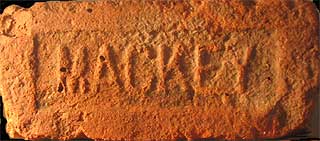
Verplanck, NY (1904) 4 machines in 1910
(found near the brickyard site in Verplanck)
==========
From: Mackey Family Genealogy Forum
Here are 5 posts re:
"Mackey yards" - Brick Manufacturer in Verplanck, NY
"I am from Verplank, and I am formerly a Mackey. I also have a "Mackey Brick" sitting on my fireplace mantle.
I am looking for information about the Mackeys from Verplank.
My history ends with my grandfather. I would love to know more."
"The Mackey Yards Brick Company was located on River Road (AKA Riverview Ave), next to or where the Sea Plane Base is. If you go across the street from there, there is a foundation of a house that use to stand there (my grandparents William & Alene) lived there. You can probably find a Mackey Brick there."
"Apparently, there were many brick yards in Verplanck's Point.
I am looking for the parents of Lewis David MACKEY b ca 1845 and spouse Mary Elizabeth DYKEMAN b ca 1847. Apparently Lewis and Mary married in Verplanck and their first 2 children were born there. It appears that Lewis was involved in brickmaking or brick transporting (boatman), in Verplanck and later in South
"My grandmother, Josie Mackey, b. 1877, parents Lewis David Mackey b. abt 1847 and Mary Elizabeth Dyckman b. abt 1849, marriage record of 1868 Courtlandtown Reformed Church.
Mary was from Verplanck, Lewis (aka Louis Mc Ghee) might or might not have been born in the Verplanck area. Some records say Marlboro, Ulster Co., NY. Mary and Lewis had 2 children born in Verplanck: Minnie D. b. abt 1869, Cora F. b. abt 1871. The other 7 or more? were born in South River, Middlesex Co., NJ. Lewis is listed as an Engineer, Boatman in the 1870/1880 NJ US Census. I am currently assuming he was involved at that time in marine transportation of bricks, probably for Sayre and Fisher Brick Company in Sayreville, NJ, just east of South River, on the Raritan River, near Raritan Bay and NYC Harbor. I have no information on the parents of Lewis or Mary."
"My family is from Verplank. My grandparents were Alene and Grifford Mackey. My father was William, the second eldest of nine children. I also have two bricks from the brickyard that I have had since I was a child. From what I know of family history one Mackey from across the river, the Bear Mountain side, married another Mackey from the Verplank side. After several generations the brickyards were lost due to mismanagement."
Source:
https://genforum.genealogy.com/mackey/messages/1635.html
|
The Star Brick Company of New York

Found in the ruins of the Centennial Hose Firehouse, Peekskill, NY (see OBV (above))
From Westchester County Incorporation Records, 1876-1914:
-Avery, James D., The Star Brick Company of New York, Manufacturing, milling, refining, Cortlandt 10/23/1889
-Coleman, John C., The Star Brick Company of New York, Manufacturing, milling, refining Cortlandt 10/23/1889
-Nickerson, Charles W., The Star Brick Company of New York, Manufacturing, milling, refining Cortlandt 10/23/1889
Also listed:
-Martin, Robert C., The Montrose Point Brick Company, Cortlandt, 1/24/1890
-Peck, Nathan, The Montrose Point Brick Company, Cortlandt, 1/24/1890
Nathan Peck and Robert Martin also operated The Peck & Martin Brick Company which may also have used a "Star" logo.
|
Search This Site For Brick Info:
|
To search the page you are on, Hit CTRL-F
|
|

|
|